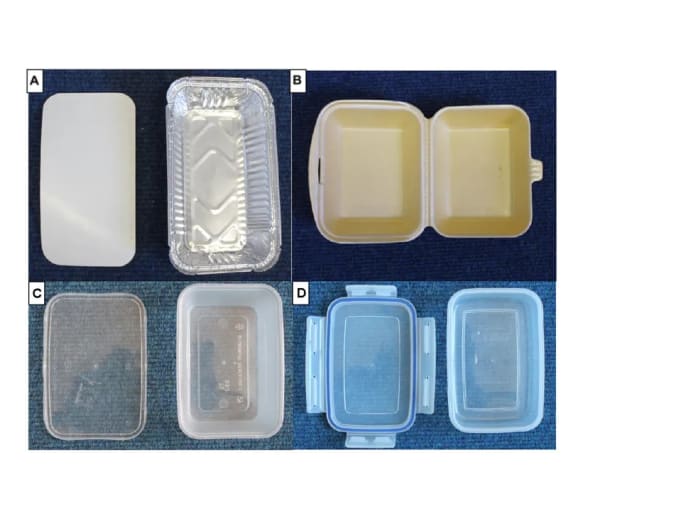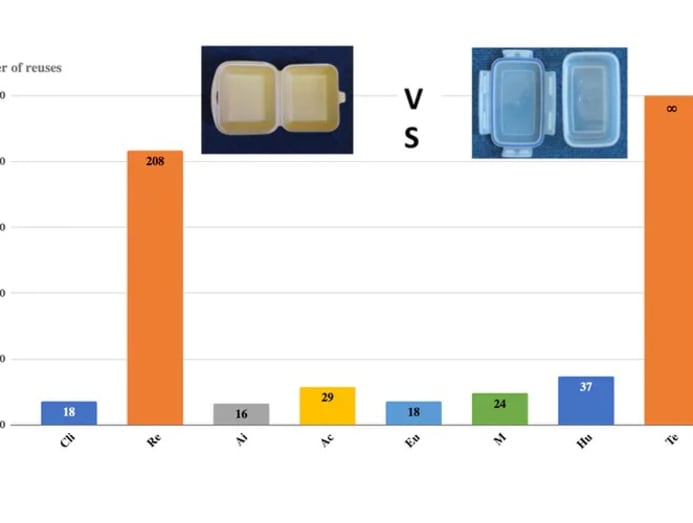Commentary: Reusable containers are not always better for the environment than disposable plastic ones
MANCHESTER: We are facing a waste crisis, with landfills across the globe at full chapters and mountains of "recycled" waste material dumped in developing countries.
Nutrient packaging is a major source of this waste, giving rising to an manufacture of "environmentally friendly" reusable nutrient and drink containers that is projected to exist worth £21.3 billion (U.s.$29 billion) worldwide by 2027, well over double its 2022 value of £ix.6 billion.
Just while information technology might seem similar reusing the same container is improve than buying a new single-use one each time, our research shows that reusable containers could actually exist worse for the environment than their disposable counterparts.
Reusable containers take to exist stronger and more durable to withstand existence used multiple times - and they have to exist cleaned after each use - so they eat more materials and free energy, increasing their carbon footprint.
Our research set out to sympathize how many times you have to reuse a container for it to exist the more eco-friendly option, in the context of the takeaway nutrient industry.
We looked at three of the nigh widely used types of single-use takeaway containers: Aluminium, polypropylene (PP) and extruded polystyrene (commonly known as Styrofoam, but correctly referred to as EPS).

We compared these with commonly used reusable polypropylene nutrient containers, pop amidst eco-witting consumers.
Impact OF RESOURCE CONSUMPTION FOR REUSABLES
The results showed clearly that Styrofoam containers are by far the all-time option for the environment amidst single-use food containers.
This is mainly due to their use of only 7.8g of raw materials compared with PP containers' 31.8g. Also, they crave less electricity for production compared with aluminium containers.
Even a reusable container would have to exist reused between 16 and 208 times for its ecology impact to equal that of a single-utilise Styrofoam container.
Nosotros assessed 12 environmental impacts beyond the entire life cycle of a nutrient container. These included the container'south contribution to global warming and to acid rain, its toxicity to humans and natural ecosystems and its effects on the ozone layer.
Taking these into business relationship, you lot would have to reuse a container 16 times to counteract the bear upon on air pollution of using the unmarried-utilize container - and 208 times to counteract the affect of resource consumption.
When it comes to endangering our landscapes, reusable containers are always a worse pick - regardless of the number of times used - due to the electricity required to heat the h2o for washing them. This is thanks to the emission of substances like heavy metals in electricity generation, which are toxic to many country-based organisms.
Similar results to ours accept been reported for coffee cups, with ane study last that it takes between xx and 100 uses for a reusable cup to offset its higher greenhouse gas emissions compared to a dispensable loving cup.
Being REALISTIC ABOUT RESUSE
A common criticism of Styrofoam containers is that they are non currently recycled.
Although technically possible, the depression density of Styrofoam (containing 95 per cent air) ways that vast amounts demand to exist collected and compressed before they can exist shipped to a recycling plant, making Styrofoam recycling economically tricky.
However, we found that increasing recycling rates for the three types of single-apply takeaway containers to the level of the European Union'due south 2025 packaging waste recycling target - 75 per cent for aluminium and 55 per cent for plastic - would reduce their impacts past 2 per cent to 60 per cent.
This includes an almanac drib in carbon emissions equivalent to taking 55,000 cars off the route.
That does not mean that reusing containers is always worse for the planet. We only need to be realistic about the number of reuses it takes to brand ecology sense.
In an era where cheap goods are abundant on online shopping platforms, will people pay more for sustainably produced appurtenances? A NTU marketing practiced discusses on The Climate Conversations:
Merely reuse is a considerable claiming for an manufacture optimised for on-the-go consumption.
Unless it is highly user-friendly or they are offered an incentive, such as money dorsum, customers are not likely to carry around empty containers until they can render or reuse them. There are also potential issues with liability for food poisoning and cantankerous-contagion from allergens when reusing containers.
Despite this, reuse has been shown to work in the takeout sector, as with reusable box schemes similarreCIRCLE in Switzerland. However, systems like this require considerable investment, particularly to help customers return containers.
A more promising model may be ane where the vendor directly collects empty containers from the customer to be refilled with the same substance, in the fashion of sometime-fashioned milk delivery rounds. Similar models, like Terracycle's Loop, aim to reuse each container upward to 100 times.
INDIVIDUAL PACKAGING CHOICES HAVE LIMITED INFLUENCE
Unfortunately, single-use takeaway containers frequently end upwards contaminating natural environments. Almost half of the plastic polluting the earth'southward oceans comes from takeaway containers.
But instead of switching from single-use, a ameliorate environmental solution may be to encourage food companies to invest in more than efficient recycling systems worldwide.

The takeaway bulletin?
Private packaging choices will have limited influence equally long as the whole system remains in need of a complete overhaul. For example, a consumer might opt for a compostable container, only that volition not help if their area does not have an industrial composting facility.
Information technology is time we shifted packaging design from being product-based - focused on providing maximum features and functionality - to user-centred, focusing on improving customers' lives by empathising with their desires for a cleaner earth.
That means coupling environmentally sound and depression-bear upon materials with a waste matter infrastructure that appreciates how humans actually behave and is designed to help them lead sustainable lives.
When convenience and sustainability are pursued together, everyone wins.
Alejandro Gallego Schmid is Senior Lecturer in Circular Economic system and Life Wheel Sustainability Assessment at the University of Manchester. Adisa Azapagic is Professor of Environmental Chemical Engineering at the same university. Joan Manuel F Mendoza is Research Boyfriend in Round Economy and Industrial Sustainability at the Ikerbasque Foundation. The commentary commencement appeared on The Conversation.
0 Response to "Commentary: Reusable containers are not always better for the environment than disposable plastic ones"
Post a Comment